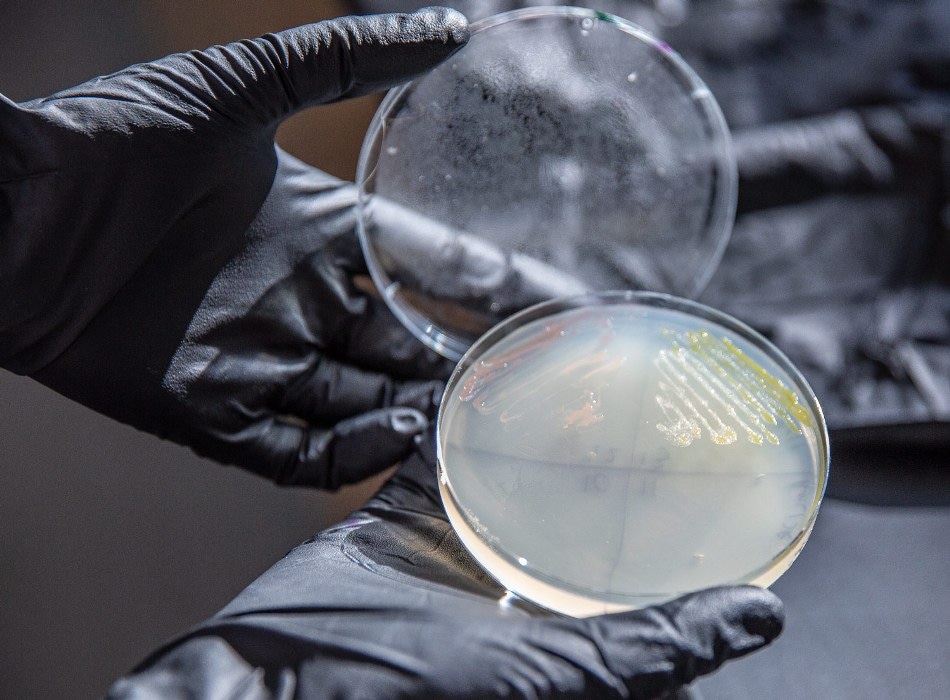Mar 7 2019
With a few genetic modifications, a type of soil bacteria which feeds on hydrocarbons shows potential as a biological factory for turning a renewable—but disappointingly untapped—reward into a replacement for omnipresent plastics.
 University of Wisconsin–Madison postdoctoral researcher Alex Linz examines a plate streaked with N. aromaticivorans (in yellow), a soil bacterium that could turn a renewable source—lignin from plant cells—into a replacement for petroleum-based plastics. (Image credit: CHELSEA MAMOTT, GLBRC)
University of Wisconsin–Madison postdoctoral researcher Alex Linz examines a plate streaked with N. aromaticivorans (in yellow), a soil bacterium that could turn a renewable source—lignin from plant cells—into a replacement for petroleum-based plastics. (Image credit: CHELSEA MAMOTT, GLBRC)
Scientists, such as those at the University of Wisconsin–Madison-based, Department of Energy-funded Great Lakes Bioenergy Research Center, who are expecting to convert woody plants into a substitute for petroleum in the production of fuels and other chemicals, have been looking at the sugars in the fibrous cellulose that constitutes most of the plants’ cell walls.
Much of the work of acquiring those sugars involves the removal of lignin, a polymer that fills the spaces between cellulose and other chemical constituents in the cell walls.
This process results in plenty of useful cellulose, and also a lot of lignin, which has never been considered useful. For over 100 years, paper mills have been removing lignin from wood to make paper and finding very little value in the lignin that it is merely burned in the mills’ boilers.
They say you can make anything from lignin except money.
Miguel Perez, Graduate Student, Civil and Environmental Engineering, UW–Madison.
However, they may not be aware of Novosphingobium aromaticivorans and also what it does.
Perez, civil and environmental engineering professor Daniel Noguera, and colleagues at GLBRC and the Wisconsin Energy Institute have reported in the journal Green Chemistry about an approach for using N. aromaticivorans to convert lignin into a more useful product.
“Lignin is the most abundant source—other than petroleum—of aromatic compounds on the planet,” Noguera says, similar to those used to produce plastics and chemicals from petroleum. However, the big and complicated lignin molecule is extremely challenging to efficiently break into useful constituent parts.
The researchers got involved in the bacterium, which was first isolated while flourishing in soil rich in aromatic compounds after contamination by petroleum products.
While other microbes pick and choose, N. aromaticivorans has a biological funnel for the aromatics in lignin. Its specialty is that it can breakdown almost all of the different pieces of lignin into smaller aromatic hydrocarbons.
Other microbes tried before may be able to digest a few types of aromatics found in lignin. When we met this microbe, it was already good at degrading a wide range of compounds. That makes this microbe very promising.
Miguel Perez, Graduate Student, Civil and Environmental Engineering, UW–Madison.
During its digestion process, the microbe converts those aromatic compounds into 2-pyrone-4,6-dicarboxylic acid—more commonly called PDC. By eliminating three genes from their microbe, the scientists converted the intermediate PDC into the final stage. These engineered bacteria turned out to be a funnel where the different lignin pieces enter, and where PDC flows out.
Bioengineers in Japan have used PDC to produce a range of materials that would be valuable for consumer products.
“They have found out the compound performs the same or better than the most common petroleum-based additive to PET polymers—like plastic bottles and synthetic fibers—which are the most common polymers being produced in the world,” Perez says.
If only PDC were easier to acquire, it would be an appealing plastic substitute, one that would degrade naturally in the environment, and would not percolate hormone-mimicking compounds into the water.
There’s no industrial process for doing that because PDC is so difficult to make by existing routes. But if we’re making biofuels from cellulose and producing lignin—something we used to just burn—and we can efficiently turn the lignin into PDC, that potentially changes the market for industrial use of this compound.
Daniel Noguera, Civil and Environmental Engineering Professor, UW–Madison.
Presently, the engineered modification on N. aromaticivorans can convert at least 59% of lignin’s potentially useful compounds into PDC. However, the new research shows greater promise, and Perez has goals for further manipulation of the microbe.
“If we can make this pipeline produce at a sufficient rate, with a sufficient yield, we might create a new industry,” Noguera says.
A patent application has been filed on this technology by the Wisconsin Alumni Research Foundation.
This work was funded by grants from the department of energy (BER DE-FC02-07ER64494 AND DE-SC0018409) and the Chilean National Commission for Scientific and Technological Research.